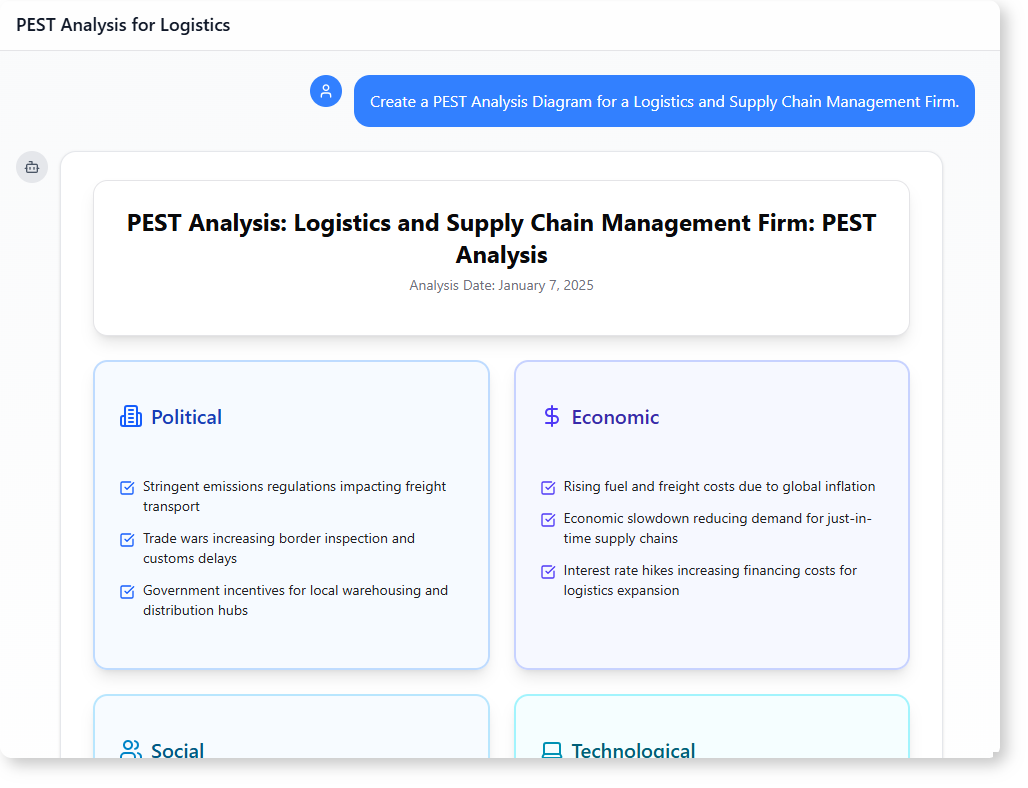Now Reading: How to Generate a PEST Analysis for Logistics with AI-Powered Modeling Software
-
01
How to Generate a PEST Analysis for Logistics with AI-Powered Modeling Software
How to Generate a PEST Analysis for Logistics with AI-Powered Modeling Software
How to Generate a PEST Analysis for Logistics with AI-Powered Modeling Software
Imagine a logistics company in the middle of a supply chain shift. Fuel prices are rising, regulations are tightening, and customers now demand faster, greener delivery. How do you react?
The answer starts with a clear understanding of the external environment — and that’s where AI-powered modeling software comes in.
This isn’t just about creating diagrams. It’s about seeing how political, economic, social, and technological forces shape your supply chain decisions. With a few simple prompts, you can generate a detailed, structured PEST analysis tailored to your industry.

Why a Logistics Manager Needs a PEST Analysis
Logistics isn’t just about moving goods. It’s about navigating a complex ecosystem of global trends.
A PEST analysis helps identify:
- How government rules affect freight
- How inflation impacts delivery costs
- What customers now expect from delivery timelines
- How new tech like IoT or AI can improve visibility
Without this visibility, decisions can be reactive, not strategic. That’s why a dedicated AI-powered modeling tool is valuable — it turns abstract concepts into actionable insight.
A Real-World Example: A Logistics Firm at Work
Let’s walk through a typical user journey.
User Background: Maria is a supply chain operations manager at a mid-sized logistics firm. Her team handles regional deliveries across Europe and Asia. Recently, her company received a customer complaint about delivery delays. She wants to understand the root causes and improve responsiveness.
Objective: To create a PEST analysis that explains how external forces are impacting delivery timelines and customer expectations.
Step-by-Step Journey with the AI Chatbot:
-
Maria opens the AI modeling tool and types: “Create a PEST Analysis Diagram for a Logistics and Supply Chain Management Firm.“
The system responds by generating a clean, structured PEST diagram with four core elements: Political, Economic, Social, and Technological.
-
She expands the diagram by asking: “Expand the diagram into a well-structured article covering each PEST element.“
The AI analyzes the context and delivers a detailed breakdown with real-world examples.
- Political: Stringent emissions regulations are making freight transport more expensive. Trade wars are adding delays at borders due to increased inspections.
- Economic: Rising fuel and freight costs are pressing. An economic slowdown is reducing demand for just-in-time models.
- Social: Customers now expect fast, sustainable delivery. There’s growing demand for supply chain transparency and ethical practices.
- Technological: IoT sensors are being used to track vehicles in real time. AI is improving demand forecasts. Blockchain is increasing traceability across routes.
-
The output is not just a list — it’s a narrative that connects each factor to business operations.
For instance, the AI explains how fuel inflation directly affects delivery windows, or how social expectations are pushing companies to adopt greener practices.
What Makes This AI-Powered Modeling Software Different?
Most tools ask you to build the diagram manually. This one listens.
It understands the field — logistics, supply chain, operations — and responds with relevant, factual, and context-aware insights.
Unlike generic tools, this AI doesn’t guess. It builds a PEST analysis based on real-world industry dynamics. The output is structured, insightful, and ready to be used in reports or strategy meetings.
The key strength is in the depth of context. The AI doesn’t just generate a diagram — it explains why each factor matters, and how it affects your business.
The Value Beyond the Diagram
The true power lies in the interpretation.
When you ask for an expanded version, you get:
- Clear explanations of each PEST factor
- Real-world examples tied to logistics operations
- A logical flow that helps teams understand the big picture
This level of detail helps teams make better decisions — whether it’s adjusting delivery strategies, investing in new tech, or rethinking workforce models.
No more guessing what’s driving changes in delivery times or customer complaints. The AI provides a clear, data-informed picture.
Is This the Right Tool for Your Supply Chain?
If you’re in logistics, transportation, or supply chain management, you’re likely facing external pressures that change daily. A static PEST analysis sheet won’t keep up.
An AI-powered modeling software that adapts to your context — and delivers structured, relevant analysis — is a practical solution.
It helps you turn questions like “Why are deliveries delayed?” into actionable insights, without relying on manual research or spreadsheets.
FAQ
Q: Can I use this AI to generate a PEST diagram for my supply chain?
A: Yes. Simply describe your business context — such as logistics or distribution — and the AI will generate a relevant PEST analysis tailored to your sector.
Q: Does the AI understand the nuances of supply chain challenges?
A: Yes. The AI has been trained on real-world logistics and supply chain scenarios, so it recognizes factors like trade delays, fuel costs, and customer expectations.
Q: How does the AI structure the analysis?
A: The AI organizes the PEST elements into a clear, logical format — Political, Economic, Social, Technological — and explains each with industry-relevant examples.
Q: Can I use this to improve decision-making in my team?
A: Absolutely. The output is designed to be shared in meetings. Each section highlights practical impacts — from delivery times to workforce needs — making it easy to discuss in strategy sessions.
Ready to map out the external forces affecting your logistics operations? Give our AI-powered modeling software a try at Visual Paradigm’s AI Chatbot today!
